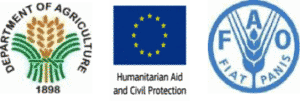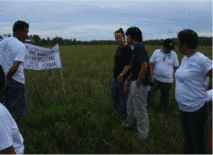“The Grains in Salt”: A Story of Jun Hernan
 Understanding the effects of saltwater intrusion on rice farming has convinced farmer Jose “Jun” Hernan to use a saline-tolerant rice variety (NSIC Rc-182). The result has brought vibrancy in rice cultivation in the saltwater intruded coastal barangay of Boton, Casiguran. The use of the stress-tolerant crop can help ensure food on the table and income for Jun’s family. The rice variety he currently uses is “Triple 2” (NSIC Rc-222), a long-maturing rice variety under normal conditions which produces 70 cav/ha. But when saltwater intrudes the rice field, yield loss can range from 50% (35 cavans) to a 100%. Current data show that the good practice option saline-tolerant variety (NSIC Rc-182) has produced 50 cavans/ha (Table 1). This has provided food on the table and boosts his confidence in farming his saltwater intruded rice fields.
Understanding the effects of saltwater intrusion on rice farming has convinced farmer Jose “Jun” Hernan to use a saline-tolerant rice variety (NSIC Rc-182). The result has brought vibrancy in rice cultivation in the saltwater intruded coastal barangay of Boton, Casiguran. The use of the stress-tolerant crop can help ensure food on the table and income for Jun’s family. The rice variety he currently uses is “Triple 2” (NSIC Rc-222), a long-maturing rice variety under normal conditions which produces 70 cav/ha. But when saltwater intrudes the rice field, yield loss can range from 50% (35 cavans) to a 100%. Current data show that the good practice option saline-tolerant variety (NSIC Rc-182) has produced 50 cavans/ha (Table 1). This has provided food on the table and boosts his confidence in farming his saltwater intruded rice fields.
 Jun observed that the good practice option rice variety was resistant to salinity, “ma resistensiya sa askad,” he expressed in the local dialect. Later on, farmer cooperators Jose Lagsit, Rosallo Laura and 5 others replicated the use of the GPO variety in their farms in barangay Boton, Casiguran.
Jun observed that the good practice option rice variety was resistant to salinity, “ma resistensiya sa askad,” he expressed in the local dialect. Later on, farmer cooperators Jose Lagsit, Rosallo Laura and 5 others replicated the use of the GPO variety in their farms in barangay Boton, Casiguran.
With the result, Jun will increase the area planted to this saline-tolerant variety to 3,000 sq meters. He will also now better protect the seedbed from birds and flash floods. And as an officer of Boton Irrigators Association (BIA), he will re-echo the things that he learned by sharing the knowledge and tools on disaster risk reduction and management in agriculture to his members.
Table 1: Cost and return of Saline-affected rice farm. Jun Hernan. Boton, 2013
items | Existing Variety | Saline-tolerant Variety | Difference |
Yield (t/ha) | 1.6 | 2.3 | 0.7 or 15 cavans |
Gross income (PHP) | 28,175 | 40,250 | 12,075 |
Cost of production (PHP) | 10,485 | 11,485 | 1,000 |
Net income (PHP) | 17,690 | 28,765 | 11,075 |
Maturity (days) | 120 days | 100 | 20 days |
ROI (%) | 62.7 | 71.5 |
|
